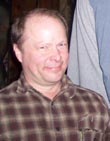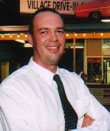|
|
 
|
|
Author
|
Topic: Drive-in Cinema Screens
|
Peter Sheridan
Film Handler
Posts: 3
From: Hornsby Heights, Australia
Registered: Jun 2001
|
 posted 07-01-2001 09:49 AM
posted 07-01-2001 09:49 AM




Dear All
I am interested in discussing materials used in building Drive-in Cinema screens. The screens at my Cinema chain in Sydney Australia are of 2 types, Cement surfaced or Ripple steel sufaced. Their average size is 100ft by 50ft. The cement surface produces great results in all but extreme weather conditions but the the ripple (corrugated) steel produces different results from location to location.
On some steel screens a shiny checkerboard pattern appears on heavy dew nights but not on others. During rain, again the steel surfaces produce different results some producing wet shiny and very annoying patterns while others show no effect at all. Is it the paint, surface, or maybe the frame?. What can we do to fix this problem. It has always been a mystery to us and I hope someone can shed some light.Peter Sheridan
| IP: Logged
|
|
|
|
|
|
|
|
John Pytlak
Film God

Posts: 9987
From: Rochester, NY 14650-1922
Registered: Jan 2000
|
 posted 07-01-2001 01:09 PM
posted 07-01-2001 01:09 PM





When a drive-in screen gets wet, it usually becomes more specular (mirror-like) in its reflection. So the corregated surface reflects light uniformly when dry, but very directionally when wet, accentuating the rippled surface.------------------
John P. Pytlak, Senior Technical Specialist
Worldwide Technical Services, Entertainment Imaging
Eastman Kodak Company
Research Labs, Building 69, Room 7419
Rochester, New York, 14650-1922 USA
Tel: 716-477-5325 Cell: 716-781-4036 Fax: 716-722-7243
E-Mail: john.pytlak@kodak.com
Web site: http://www.kodak.com/go/motion
| IP: Logged
|
|
John Wilson
Film God

Posts: 5438
From: Sydney, Australia.
Registered: Dec 1999
|
 posted 07-02-2001 03:44 AM
posted 07-02-2001 03:44 AM




Hi PeterWelcome to the forum! How've you been? On wet nights we used to advise the patrons to park off-centre to avoid the white spot on the screen. The ripple effect was also very prominent in the early mornings as the cold weather and the dew were affecting the screen. I can't recall what it was they used to coat them, but every time they were painted they said it would solve most problems...but we never saw too much difference...just a brighter picture, which was always nice.  If you want to take a look at my old haunts, then Click Here and then Click Here Too! Come on out to the Ritz soon and take a look at Film Guard in action. It'll knock your socks off. John ------------------
"If you think THIS is fantastic...wait until you see the full effect with the HIMP!"
- Chief Inspector Clouseau.
| IP: Logged
|
|
Peter Berrett
Jedi Master Film Handler

Posts: 602
From: Victoria, Australia
Registered: Nov 2000
|
 posted 07-02-2001 03:59 AM
posted 07-02-2001 03:59 AM





Hi PeterFunny that this subject should come up now. Last night I was at Coburg Drive-in here in Melbourne (watching Swordfish) on Coburg's big screen 1. I noticed something different that night. I noticed what appeared to be vertical ripples running through the screen. The effect was somewhat like having a dusty tv screen too as soem bits of the screen shone brighter than others. It is quite annoying. Noticeably that night there was a bit of fog about. I haven't looked closely but I guess the screen is made of corrugated iron with the ripples running vertically. It seems to confirm comments made earlier by others. I recommend you go with a flat screen. cheers Peter
| IP: Logged
|
|
Tom Hutchinson
Film Handler

Posts: 11
From: Edmonton, Alberta, Canada
Registered: May 2001
|
 posted 07-02-2001 04:23 PM
posted 07-02-2001 04:23 PM




It is my understanding that the corrogated steel gives the projected light beam essentially 3 different surfaces to light, at 3 different angles...because the projector is at a right angle to the screen.Another source of light, say the moon, or field lights, or parking lot lights from the gas station next door, will likely only hit one or at most two of those surfaces, thus making the effect of the stray light less noticeable. In this territory, the best screens were corrogated steel; the worst were plywood. They are pretty well all gone now. Tom
| IP: Logged
|
|
David Kilderry
Master Film Handler

Posts: 355
From: Melbourne Australia
Registered: Sep 1999
|
 posted 07-03-2001 06:32 AM
posted 07-03-2001 06:32 AM





Early drive-in screens were either cement block or marine ply, both flat surfaces. As John and others correctly point out, when these became wet due to rain or moisture in the air, they became more specular. In other words they produced a hot spot. The reflectivness or gain of the paint on the surface would accentuate this.Corrugated sheet screens began to appear in an attempt to deflect this annoying relection in a number of angles and not all back toward the centre of the field. Some were successful, others not. From my experience, I have found that a flat zinc-alum panel is the best drive-in screen material for all weather conditions. Coburg triple has one corrugated screen and two flat panel screens, the flat panel screen is certainly the best when wet compared to the other and has the same light with the same lamphouse and lens setup as the corrugated screen. I have noticed the annoying reflection at both Bass Hill and Blacktown as Peter states. I would suggest Wattyl Solarguard paint. This was found to be the best all round paint available. It provides good reflective qualities without annoying hot spots. The big drive-in circuits once had a great deal of accumulated information on topics such as these. Unfortunately much of this research and knowledge is lost or not available to the independant drive-in operator. The company I work for once had 40 drive-ins and thankfully most of this information has been retained and is still put to good use. I'll say it again, the single most important tool when considering any aspect of theatre screen light is the cine spot meter. It amazes me how many large circuits still do not own one. You are chasing shadows and guessing in the dark without one. When a drive-in in particular needs every ounce of light available, a quality meter is invaluable. David Kilderry
| IP: Logged
|
|
Peter Sheridan
Film Handler
Posts: 3
From: Hornsby Heights, Australia
Registered: Jun 2001
|
 posted 07-03-2001 06:59 AM
posted 07-03-2001 06:59 AM




Hi David, John and all.Nice to see so much experience here. Should have found this forum a lot earlier. The answers you all supplied certainly help for my info and I agree with you David, but so much has been lost to time. I suppose we have to be thankful that we still have some Drive-ins still in operation and by and large still maintained very well. Currently the Blacktown location is about to receive a complete ground resurfacing. The screen at Bass Hill has been cleaned and a anti bird guard applied to the top to keep it white for as long as possible. Getting back to screen materials, I think of all the screens I have seen from both an operators and a patrons point of view, the cement is the best. I have seen blinding storms drenching the screen yet it still seems to hold up well. The tinny starts reflecting if you breath on it the wrong way  One metal screen is not too bad but seems to be rather over engineered. I was theorising that maybe the massive frame works as a kind of temperature ballast in cold weather. Thanks too all for the info. Now all we have to do is get more light onto the screen, or will this accentuate the problem? One metal screen is not too bad but seems to be rather over engineered. I was theorising that maybe the massive frame works as a kind of temperature ballast in cold weather. Thanks too all for the info. Now all we have to do is get more light onto the screen, or will this accentuate the problem? Peter
| IP: Logged
|
|
John Pytlak
Film God

Posts: 9987
From: Rochester, NY 14650-1922
Registered: Jan 2000
|
 posted 07-03-2001 09:01 AM
posted 07-03-2001 09:01 AM





David Kilderry said: "I'll say it again, the single most important tool when considering any aspect of theatre screen light is the cine spot meter. It amazes me how many large circuits still do not own one. You are chasing shadows and guessing in the dark without one. When a drive-in in particular needs every ounce of light available, a quality meter is invaluable."Wonderful advice. Kodak has published information on screen luminance meters:
Screen Luminance Meters Here are some links to various meters:
Minolta LS-100
USL PSA-200
Spectra-Cine Meter Again, the cost of a good meter seems high, but the meter can be shared by many screens, and should last indefinitely. You wouldn't think of aligning a sound system without the proper equipment, why not have the right tool to assure proper screen luminance?
------------------
John P. Pytlak, Senior Technical Specialist
Worldwide Technical Services, Entertainment Imaging
Eastman Kodak Company
Research Labs, Building 69, Room 7419
Rochester, New York, 14650-1922 USA
Tel: 716-477-5325 Cell: 716-781-4036 Fax: 716-722-7243
E-Mail: john.pytlak@kodak.com
Web site: http://www.kodak.com/go/motion
| IP: Logged
|
|
|
|
All times are Central (GMT -6:00)
|
|
Powered by Infopop Corporation
UBB.classicTM
6.3.1.2
The Film-Tech Forums are designed for various members related to the cinema industry to express their opinions, viewpoints and testimonials on various products, services and events based upon speculation, personal knowledge and factual information through use, therefore all views represented here allow no liability upon the publishers of this web site and the owners of said views assume no liability for any ill will resulting from these postings. The posts made here are for educational as well as entertainment purposes and as such anyone viewing this portion of the website must accept these views as statements of the author of that opinion
and agrees to release the authors from any and all liability.
|

 Home
Home
 Products
Products
 Store
Store
 Forum
Forum
 Warehouse
Warehouse
 Contact Us
Contact Us




 Printer-friendly view of this topic
Printer-friendly view of this topic















